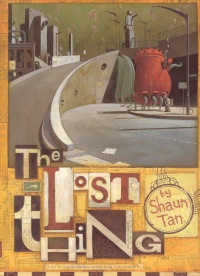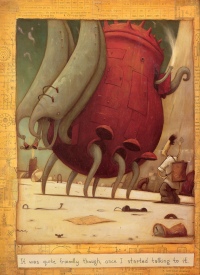| ________________
CM . . .
. Volume XI Number 14 . . . . March 18, 2005
excerpt:
The narrator's story about the lost "thing" is reminiscent of a narrative about a lost dog. The boy tells readers about the day he befriended a lost thing, a surreal creature that resembles a pot-bellied stove with crab pinchers. After engaging in an afternoon of companionable activities on the beach, it is time for the boy to go home. He asks others about the lost thing's identity, but his inquiries are futile. Predictably, the boy takes the lost thing home. Initially his parents are oblivious to the lost thing's presence and, even when the boy points out the thing, his parents express only momentary concerns about filthy feet and strange diseases. The boy hides the lost thing in the back shed and feeds it a meal of Christmas decorations. While checking the local paper for "lost pet notices," the boy happens to sees an advertisement on the last page: "Are YOU finding that the order of day-to-day life is unexpectedly disrupted by unclaimed property?" The following morning, the boy and the thing take a tram into the city to locate the address provided in the advertisement. For a number of reasons, the two companions are disheartened once they find the "tall Grey Building #357b." Another "thing" gives the boy a business card with an arrow on it and tells him, "If you really care about that thing, you shouldn't leave it here." The two follow the signs and eventually reach their destination. Tan narrates the story in a familiar and simple mode. Indeed the text a letter or a journal entry or a school assignment of "What I did during the summer holidays" seems to have been written on lined paper, cut into sections and then glued onto the pages. The setting of the story depicts a highly bureaucratic, industrialized, mechanized, and polluted world that seems disinterested and dispassionate, a world that has lost its ability to "see" the unique, the mysterious, the individual. So what is really "the lost thing"? The understated story is satirical and metaphorical, and open to multiple readings and meanings for a variety of audiences.
Tan includes a wordless double-page spread that must be turned vertically to be read, and on the last page readers must turn the book upside down to read the text, "And apologies to Jeffrey Smart, Edward Hopper & John Brack." Tan is admitting his emulation, sometimes parodic, of the work of these painters. The dust jacket, end papers and title page provide further visual and textual information for readers to interpret. The bottlecaps on the end pages are superimposed on what appears to be drafts of Tan's illustrations for the book. The Lost Thing was Tan's first self-authored and illustrated picture book. It was first published in 2000 and like his other work (e.g., The Viewer, The Rabbits, The Red Tree), it is a sophisticated and multifaceted production. In the United Kingdom, Passion Pictures is currently working on animated film version based on The Lost Thing. Highly Recommended. Sylvia Pantaleo is a language arts professor in the Faculty of Education, the University of Victoria, in Victoria, BC.
To comment
on this title or this review, send mail to cm@umanitoba.ca.
Copyright © the Manitoba Library Association. Reproduction for personal
use is permitted only if this copyright notice is maintained. Any
other reproduction is prohibited without permission.
NEXT REVIEW |TABLE OF CONTENTS FOR THIS ISSUE
- March 18, 2005.
AUTHORS
| TITLES | MEDIA REVIEWS
| PROFILES
| BACK ISSUES
| SEARCH | CMARCHIVE
| HOME |

 The predominantly earth tone illustrations set the mood of the story. Tan's mixed-media visual
composition uses bottle caps as well as pages from his father's old physics and engineering
textbooks. Every page is completely filled, and in many instances words from the textbooks seem to
be placed strategically, adding further layers of meaning. On several pages, text is superimposed on
a picture, appearing simultaneously as both picture and words. The Federal Department pig stamps
with "latin" text are most amusing. The recurring image of the arrow is only one of several motifs
for readers to consider. The intricate detail in Tan's illustrations is fascinating and demands close
scrutiny and multiple viewings as much of the artwork in the book encapsulate subtle symbolism. The Lost Thing encourages and rewards careful observation on every page readers can point
and click on varying images or texts with their eyes.
The predominantly earth tone illustrations set the mood of the story. Tan's mixed-media visual
composition uses bottle caps as well as pages from his father's old physics and engineering
textbooks. Every page is completely filled, and in many instances words from the textbooks seem to
be placed strategically, adding further layers of meaning. On several pages, text is superimposed on
a picture, appearing simultaneously as both picture and words. The Federal Department pig stamps
with "latin" text are most amusing. The recurring image of the arrow is only one of several motifs
for readers to consider. The intricate detail in Tan's illustrations is fascinating and demands close
scrutiny and multiple viewings as much of the artwork in the book encapsulate subtle symbolism. The Lost Thing encourages and rewards careful observation on every page readers can point
and click on varying images or texts with their eyes.